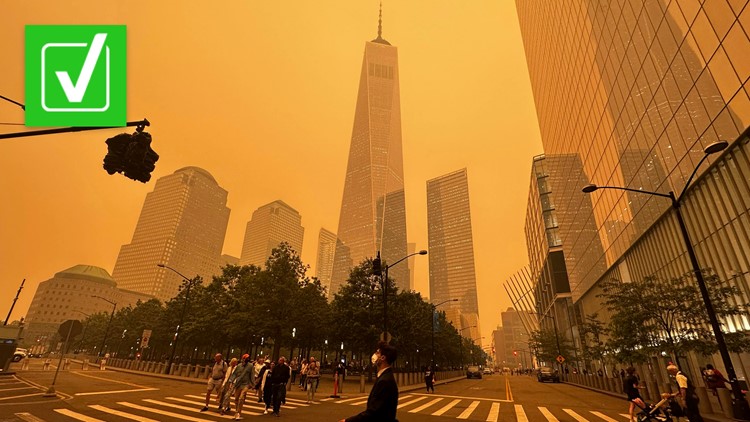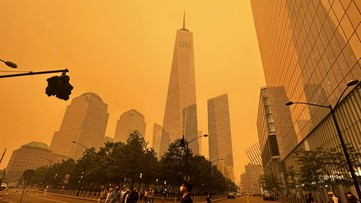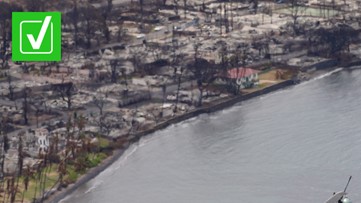The smoke from wildfires in Canada blanketed much of the eastern U.S. with a thick cloud of haze in early June. Many cities issued air quality alerts, urging residents to remain indoors if possible and protect themselves with masks if they had to go outside.
But on June 7, a guest on Fox News’ “The Ingraham Angle,” Steve Milloy, claimed that the wildfire smoke doesn’t have negative health effects.
“Look, the air is ugly, it's unpleasant to breathe, and for a lot of people, they get anxiety over it. But the reality is there's no health risk,” Milloy said. “We have this kind of air in India and China all the time — no public health emergency.”
He also said that wildfire smoke “doesn’t kill anybody” and “doesn’t make anybody cough.”
Milloy has since doubled down on his claims on his Twitter account.
THE QUESTION
Does wildfire smoke pose a health risk?
THE SOURCES
- Environmental Protection Agency (EPA)
- Centers for Disease Control and Prevention (CDC)
- American Lung Association
- Stanford University’s Institute for the Environment
- Children’s Hospital Colorado
- National Jewish Health, a respiratory hospital
- AirNow, a partnership between several federal agencies that reports official U.S. air quality data
- IQAir, an air quality technology company
THE ANSWER
Yes, wildfire smoke does pose risks to your health.
WHAT WE FOUND
Wildfire smoke is a mix of gasses and fine particles. The Centers for Disease Control and Prevention (CDC) says wildfire smoke can make healthy people sick if enough of it is in the air. Health effects from exposure to wildfire smoke can range from mild symptoms, such as eye and respiratory irritation, to more serious health issues, such as exacerbation of asthma and even heart failure, according to the Environmental Protection Agency (EPA).
The CDC says the immediate health effects of breathing in wildfire smoke include:
- Coughing, scratchy throat and trouble breathing normally
- Asthma attacks
- Stinging eyes
- Runny nose and irritated sinuses
- Chest pain
- Fast heartbeat
- Headaches
- Tiredness
The American Lung Association adds that wildfire smoke can even cause heart attacks and strokes. Stanford University’s Institute for the Environment says exposure to smoke over 5 to 7 days can cause damage to the lungs, blood and heart.
Poor air quality from wildfire smoke can cause negative long-term impacts on a child’s lungs, even in children who don’t have asthma, because their bodies are still developing, Children’s Hospital Colorado says. According to Stanford University, children exposed to five days of wildfire smoke have a twofold increase in the rate of asthma.
Elderly and pregnant people are also affected more by wildfire smoke than others, Stanford University says. Elderly people exposed to wildfire smoke can experience increased rates of heart attack and stroke, and there’s an increased risk of premature birth and decreased birth rate when pregnant people are exposed to it.
What makes wildfire smoke bad for people’s health?
Wildfire smoke is a mixture of gaseous pollutants, hazardous air pollutants, water vapor and particle pollution. Particle pollution, which is also referred to as particles, particulate matter or PM, is a general term for a mixture of solid and liquid droplets suspended in the air. The EPA says particle pollution is a principal public health threat from short and longer-term exposure to wildfire smoke.
“The air we breathe, both indoors and outdoors, always contains particle pollution. Because of their small size, particles can easily penetrate homes and buildings, increasing indoor particle concentrations,” the EPA says. “During a wildfire, concentrations of particles can substantially increase in the air to the point that particle pollution is visible to the naked eye.”
If there are more fine particles in the air, then your local air quality measures will be worse. If the air quality is worse, then you’re more likely to experience negative health effects from wildfire smoke.
The health effects of particle pollution exposure can range from eye and respiratory tract irritation to the exacerbation of asthma and heart failure, and even premature death, according to the EPA. Even in healthy people, fine particles can cause lung inflammation and passing reductions in lung function. They can also hinder the body’s ability to remove viruses and bacteria from the lungs, the EPA says.
But the dangers and effects of wildfire smoke won’t be the same from person-to-person, day-to-day or fire-to-fire. AirNow, a partnership between several federal agencies that reports official U.S. air quality data, says that not everyone exposed to wildfire smoke will experience long-term negative health effects. The amount you’re exposed to and how long you’re exposed to it plays a significant role in determining whether someone will experience smoke-related health problems.
That’s why National Jewish Health, a respiratory hospital, says low amounts of wildfire smoke won’t necessarily lead to long-term issues for healthy people, but can still cause unpleasant short-term effects. National Jewish Health says you should stay indoors as much as possible if air quality advisories recommend it.
How bad is the air quality in the places covered by smoke in early June?
For parts of June 7, 2023, when the smoke was so thick it blotted out the midday sun and gave the sky an orange color in New York City, the city’s air quality was the worst in the world, according to IQAir, an air quality technology company.
The city’s air quality was considered “hazardous” on the official U.S. Air Quality Index. Hazardous ratings, which are the worst on the scale, are for “emergency conditions” when everyone is at a higher risk of experiencing negative health effects, according to AirNow.
Many of the cities IQAir rated among the worst for fine particles in 2022 were in India, which Milloy said has this kind of air “all the time” with “no public health emergency.” In 2019, nearly 1.6 million people in India died from air pollution — including from the same fine particles found in wildfire smoke — according to the 2022 Lancet Commission on pollution and health report.













